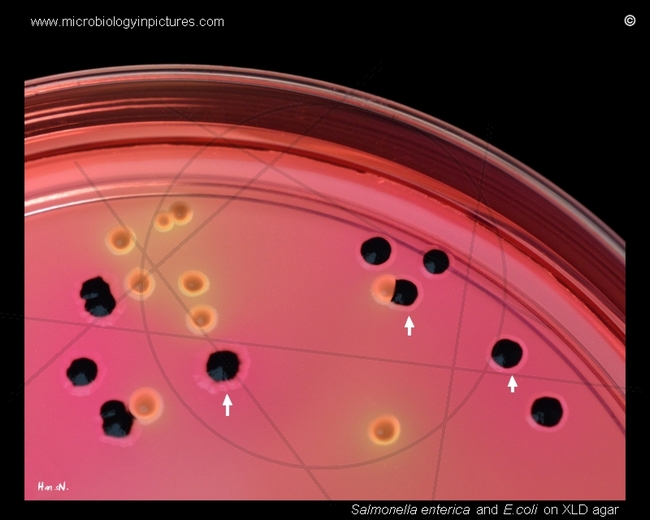Salmonella Colony Morphology - Characterization And Evaluation Of A Salmonella Enterica Serotype Senftenberg Mutant Created By Deletion Of Virulence Related Genes For Use As A Live Attenuated Vaccine Clinical And Vaccine Immunology : Salmonella typhi and paratyphi morphology.
Salmonella Colony Morphology - Characterization And Evaluation Of A Salmonella Enterica Serotype Senftenberg Mutant Created By Deletion Of Virulence Related Genes For Use As A Live Attenuated Vaccine Clinical And Vaccine Immunology : Salmonella typhi and paratyphi morphology.. To investigate irregular colony morphology formation in salmonella enterica serovar typhimurium dpc6046 in the presence of a lytic phage, felix 01. Pick 2 or more colonies of salmonella from each selective agar plate after 24 ± 2 h incubation. Basic elements you can identify in a colony morphology include the following: The most common types of salmonella are salmonella enteritidis and salmonella typhimurium, which account for half of all human infections. These findings support the hypothesis that the unusual morphology is due to reversion to phage sensitivity and consequent cell death within the colony as it forms.
To investigate irregular colony morphology formation in salmonella enterica serovar typhimurium dpc6046 in the presence of a lytic phage, felix 01. Salmonella summary morphology & physiology: By observing the colony of bacteria, the identity of bacteria will be determined. First, formation of the rugose colony morphology in s. Typhi) ⇒ the deoxycholate citrate agar (dca) medium is the selective medium for shigella dysenteriae & other shigella species as well as salmonella spp.

Colon y morphology is used simply as a mean s to.
Cultural characteristics of shigella 3. They have peritrichous flagella, although they are sometimes nonmotile. By observing the colony of bacteria, the identity of bacteria will be determined. The genus can be divided into two species (s. Typical salmonella colonies are as follows: Salmonella is genus that includes 2,300 different species of bacteria. Salmonella summary morphology & physiology: Genome sizes of salmonella vary among serovars (table 1) with ranges from 4460 to 4857 kb. Morphology and culture characteristics of salmonella typhi (s. Colony morphology is a way of identifying bacteria. Basic elements you can identify in a colony morphology include the following: I hope this video will helpful for your studie. Consult listed references for the identification of colony morphology and further biochemical tests required for identification.
The image shows the colony morphology of bacteria. Pick 2 or more colonies of salmonella from each selective agar plate after 24 ± 2 h incubation. May appear with or without black centers. Colon y morphology is used simply as a mean s to. The most common types of salmonella are salmonella enteritidis and salmonella typhimurium, which account for half of all human infections.

Salmonella typhi and paratyphi morphology.
Salmonella enterica on blood agar. Typhi) ⇒ the deoxycholate citrate agar (dca) medium is the selective medium for shigella dysenteriae & other shigella species as well as salmonella spp. Colony morphology is a way of identifying bacteria. These findings support the hypothesis that the unusual morphology is due to reversion to phage sensitivity and consequent cell death within the colony as it forms. I hope this video will helpful for your studie. Morphology and culture characteristics of salmonella typhi (s. When interpreting salmonella and shigella cultures, it is important to remember that colony morphology on selective agar is not diagnostic. Genome sizes of salmonella vary among serovars (table 1) with ranges from 4460 to 4857 kb. Colony morphology differences between thes. Salmonella typhi and paratyphi morphology. Entericaserovar typhimurium dt104 progresses over 3 to 4 days at room temperature (19 to 30°c) in tsa, while v. Consult listed references for the identification of colony morphology and further biochemical tests required for identification. Cultural characteristics of salmonella enterica salmonella enterica on nutrient agar.
Colon y morphology is used simply as a mean s to. Genome sizes of salmonella vary among serovars (table 1) with ranges from 4460 to 4857 kb. 2 to 3 µm χ 0.6 µm. May appear with or without black centers. Transparent colorless colonies with no zone of precipitation.
Consult listed references for the identification of colony morphology and further biochemical tests required for identification.
Hello viewers !!!my name is kavindu lakmal , medical laboratory science student from university of peradeniya. I hope this video will helpful for your studie. They grow on the following media and show the following characteristic colony morphology (table 7.12). Basic elements you can identify in a colony morphology include the following: The most common types of salmonella are salmonella enteritidis and salmonella typhimurium, which account for half of all human infections. I hope this video will helpful for your studie. Pick 2 or more colonies of salmonella from each selective agar plate after 24 ± 2 h incubation. Transmission electron microscopy (tem) was performed for morphological observation of mutants, as described elsewhere (23). Bongori), based on their phenotypic profile.it causes acute gastroenteritis and when salmonella infections become invasive, they can affect the bloodstream (bacteremia), bone (osteomyelitis), joint (septic. Typical salmonella colonies are as follows: Typhi) ⇒ the deoxycholate citrate agar (dca) medium is the selective medium for shigella dysenteriae & other shigella species as well as salmonella spp. Salmonella is genus that includes 2,300 different species of bacteria. The colony morphology was observed after streaking and incubation of each mutant on lb agar at 37°c for 24 h.
Komentar
Posting Komentar